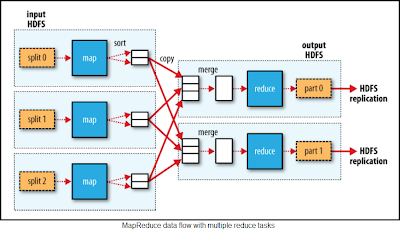Hadoop: MadReduce: Data Flow
A MapReduce job is a unit of work that the client wants to be performed. It consists of:
- the input data
- the MapReduce program
- configuration information
Hadoop runs the job by dividing it into tasks, of which there are two types:
- map tasks
- reduce tasks
There are two types of nodes that control the job execution process:
- a jobtracker
- a number of tasktrackers.
The jobtracker coordinates all the jobs run on the system by scheduling tasks to run on tasktrackers. Tasktrackers run tasks and send progress reports to the jobtracker, which keeps a record of the overall progress of each job. If a task fails, the jobtracker can reschedule it on a different tasktracker,More information go through Big data hadoop course
Hadoop divides the input to a MapReduce job into fixed-size pieces called input splits, or just splits. Hadoop creates one map task for each split, which runs the user defined map function for each record in the split.
Having many splits means the time taken to process each split is small compared to the time to process the whole input. So if we are processing the splits in parallel, the processing is better load-balanced if the splits are small, since a faster machine will be able to process proportionally more splits over the course of the job than a slower machine. Even if the machines are identical, failed processes or other jobs running concurrently make load balancing desirable, and the quality of the load balancing increases as the splits become more fine-grained.
On the other hand, if splits are too small, then the overhead of managing the splits and of map task creation begins to dominate the total job execution time. For most jobs, a good split size tends to be the size of an HDFS block, 64 MB by default, although this can be changed for the cluster (for all newly created files), or specified when each file is created.
Hadoop does its best to run the map task on a node where the input data resides in HDFS. This is called the data locality optimization since it doesn’t use valuable cluster bandwidth. Sometimes, however, all three nodes hosting the HDFS block replicas for a map task’s input split are running other map tasks so the job scheduler will look for a free map slot on a node in the same rack as one of the blocks. Very occasionally even this is not possible, so an off-rack node is used, which results in an inter-rack network transfer.

It should now be clear why the optimal split size is the same as the block size: it is the largest size of input that can be guaranteed to be stored on a single node. If the split spanned two blocks, it would be unlikely that any HDFS node stored both blocks, so some of the split would have to be transferred across the network to the node running the map task, which is clearly less efficient than running the whole map task using local data.
Map tasks write their output to the local disk, not to HDFS. Why is this? Map output is intermediate output: it’s processed by reduce tasks to produce the final output, and once the job is complete the map output can be thrown away. So storing it in HDFS, with replication, would be overkill. If the node running the map task fails before the map output has been consumed by the reduce task, then Hadoop will automatically rerun the map task on another node to re-create the map output.
Reduce tasks don’t have the advantage of data locality—the input to a single reduce task is normally the output from all mappers. In the present example, we have a single reduce task that is fed by all of the map tasks. Therefore, the sorted map outputs have to be transferred across the network to the node where the reduce task is running, where they are merged and then passed to the user-defined reduce function. The output of the reduce is normally stored in HDFS for reliability. For each HDFS block of the reduce output, the first replica is stored on the local node, with other replicas being stored on off-rack nodes. Thus, writing the reduce output does consume network bandwidth, but only as much as a normal HDFS write pipeline
consumes.

Note: The number of reduce tasks is not governed by the size of the input, but is specified independently.
When there are multiple reducers, the map tasks partition their output, each creating one partition for each reduce task. There can be many keys (and their associated values) in each partition, but the records for any given key are all in a single partition. The partitioning can be controlled by a user-defined partitioning function, but normally the default partitioner—which buckets keys using a hash function—works very well.

Finally, it’s also possible to have zero reduce tasks. This can be appropriate when you don’t need the shuffle since the processing can be carried out entirely in parallel(NLineInputFormat). In this case, the only off-node data transfer is when the map tasks write to HDFS.
Become a Master in Big data at OnlineITGuru through Big Data Online Training




No comments: